Around
the World of Carousel Art
by
Bob Brooke
A white carousel horse, frozen in a mid-air gallop, joins
other carved wooden horses, chariots—those gayly decorated booth-like
benches for the ladies in dresses–-and bejewled menagerie figures that
look back through glassy eyes on an elaborate turn-of-the-century
carousel. As drums rattle and the bellows on the old Wurlitzer band
organ wheeze and whine behind a fancy carved and painted facade, the
machine whirls at seven miles per hour. Once adults could be a knight or
a princess on a fierce, teeth-baring steed, and, with some luck, catch a
brass ring–all for the price of a nickel.
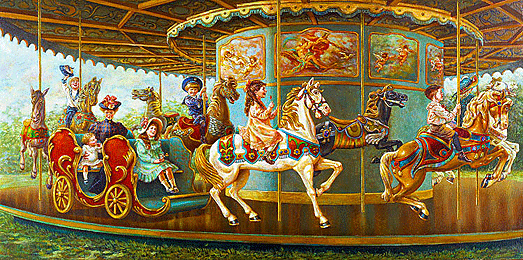
Once the centerpiece of an amusement park, this fine example of carousel
art is now housed in a protective building which overlooks the
Battleship Massachusetts, the submarine Lionfish, and World War II P.T.
and torpedo boats, part of a late 20th-Century conversion of a complex
of old mills and factory buildings known as Battleship Cove, near New
Bedford, Mass. This carousel was one of the lucky ones.
As old amusement parks closed their gates for good, their owners sold
off relics like this old carousel in pieces, often to replace broken,
missing figures on other old carousels.
At the turn of the last century, there were as many as 10,000 wooden
carousels. Today, there are about 150.
Origins
of the Carousel
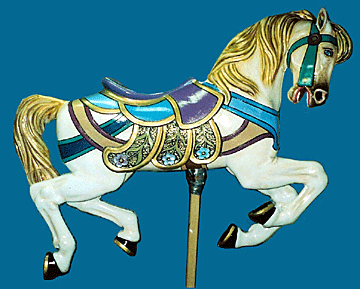 The
concept of the carousel began in the 12th Century when Turkish and
Arabian horsemen played a game on horseback. Spanish and Italian
crusaders who watched this game described it as a carosella or
"little war." In this game, riders on horseback played catch with clay
balls filled with perfumed water or oil. When a rider missed a catch,
the ball broke. This sprayed the loser and his horse with a scent. When
carosella reached the royal court of France, it developed into a
grand tournament of games called a caroussel. These were lavish
events involving hundreds of fantastically costumed horses and riders. The
concept of the carousel began in the 12th Century when Turkish and
Arabian horsemen played a game on horseback. Spanish and Italian
crusaders who watched this game described it as a carosella or
"little war." In this game, riders on horseback played catch with clay
balls filled with perfumed water or oil. When a rider missed a catch,
the ball broke. This sprayed the loser and his horse with a scent. When
carosella reached the royal court of France, it developed into a
grand tournament of games called a caroussel. These were lavish
events involving hundreds of fantastically costumed horses and riders.
They brought the game back to Europe where it became, in time, an
extravagant display of horsemanship the French called carrousel. A
popular part of every caroussel was the ring piercing contest. In
this competition, a rider on a galloping horse would use his sword to
try and spear a small gold ring suspended by ribbons from a pole.
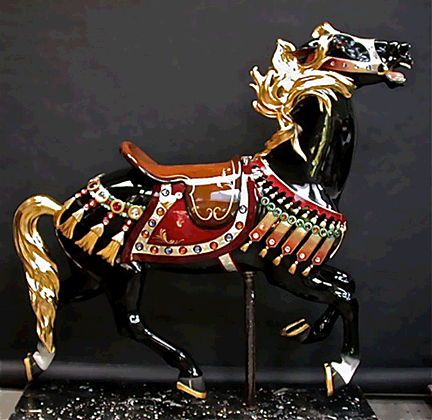 In
the early 18h Century, a Frenchman got the idea to build a device
consisting of carved horses suspended by chains from beams radiating
from a center pole, to train young noblemen in the art of ring-spearing.
The riders went round and round on their wooden horses as they tried to
spear a ring placed just outside the circle. In
the early 18h Century, a Frenchman got the idea to build a device
consisting of carved horses suspended by chains from beams radiating
from a center pole, to train young noblemen in the art of ring-spearing.
The riders went round and round on their wooden horses as they tried to
spear a ring placed just outside the circle.
Everyone enjoyed the spinning horse ride, including those who were not
in training for competition. Over time, more of these spinning devices
were built just for entertainment. Soon there were 'carousels in parks
throughout Europe and England. Because engines had not yet been
invented, rides had to be turned by horses, mules or people. Therefore,
the size stayed small.
With the invention of the steam engine, it became possible to build
bigger and heavier carousels. Some were strong enough to support animals
three or four abreast. Overhead gears allowed the .animals to move up
and down. With the advent of electric motors in the early 20th century,
carousels larger and more dazzling. Electric lights twinkled and animals
of every kind circled the giant platforms. And, just as in days of old,
riders could reach for a golden ring hanging just outside the circle.
The
Carousel Appears in the U.S.
In the U.S., farmers assembled the first carousels for their children.
After carving primitive horses, they mounted them on a simple carousel
that was usually powered by a horse or mule. By the 1870s, these
spinning playthings became more like today’s carousels, accompanied by
music and turned by engines that lifted the horses as they spun.
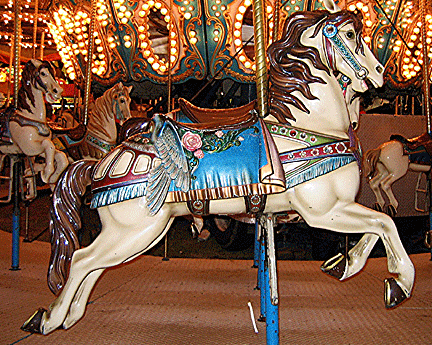 America's
first carousel factory, built by Gustav Dentzel, a young German
immigrant, began operations in 1867. Back in Germany his father,
Michael, barely supported his family by selling rides on a hand carved
merry-go-round which he moved from town to town throughout the country.
As a teenager, Gustav Dentzel helped his father operate the ride and
also learned carpentry and woodworking. He actually preferred to make
furniture, but his father insisted that he make only carousels. America's
first carousel factory, built by Gustav Dentzel, a young German
immigrant, began operations in 1867. Back in Germany his father,
Michael, barely supported his family by selling rides on a hand carved
merry-go-round which he moved from town to town throughout the country.
As a teenager, Gustav Dentzel helped his father operate the ride and
also learned carpentry and woodworking. He actually preferred to make
furniture, but his father insisted that he make only carousels.
Determined to make it on his own, Dentzel emigrated to America and
opened a small cabinetmaker's shop in Philadelphia. Business was slow at
first, so he passed the time by carving carousel animals from his
father's patterns. Soon he had enough carved animals for an entire
carousel. Cautiously, he took his carousel to several neighboring small
towns to see if Americans would pay to ride a merry-go-round. His
carousel was an instant success, so he hired other craftsmen and soon
began shipping carousels nationwide. His company, and others that
followed, produced and installed thousands of carousels across the
United States. About a century ago, they were the main attractions at
amusement parks and resorts.
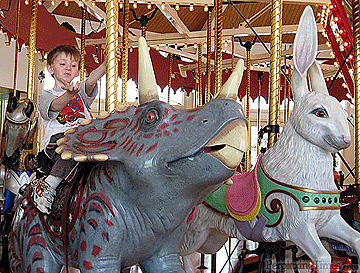 Woodworkers
in the factories designed and hand carved all the animals. Noted for
their skill and artistry, they created every kind of horse, from
stallions in full armor to gentle walkers decorated with ribbons. Often
one carver would specialize in making only heads or tails. Fanciful
carved details included flowers, flags and fringe decorating the saddles
and bridles. Although horses were the most popular animals, carvers also
created fierce tigers, tall giraffes, exotic ostriches, and many other
animals to leap and prance around the carousel base. After they finished
carving the animals, other talented artists would painstakingly paint
each figure, adding fine decorations. Soon their creations became the
centerpieces of hundreds of “trolley” parks that sprang up across the
U.S. Woodworkers
in the factories designed and hand carved all the animals. Noted for
their skill and artistry, they created every kind of horse, from
stallions in full armor to gentle walkers decorated with ribbons. Often
one carver would specialize in making only heads or tails. Fanciful
carved details included flowers, flags and fringe decorating the saddles
and bridles. Although horses were the most popular animals, carvers also
created fierce tigers, tall giraffes, exotic ostriches, and many other
animals to leap and prance around the carousel base. After they finished
carving the animals, other talented artists would painstakingly paint
each figure, adding fine decorations. Soon their creations became the
centerpieces of hundreds of “trolley” parks that sprang up across the
U.S.
But none of the old carousels of Europe could match those produced by
this group of talented American craftsmen. They made their carousels
larger and elaborately housed them in fanciful superstructures. They
carved their animals—all types of horses, animals of the jungle, plains,
farm and forest, even dogs, cats, teddy bears, and mythical beasts—more
beautifully and in a richer variety of styles. Any creature out of a
child’s dream that was rideable could be found on their carousels.
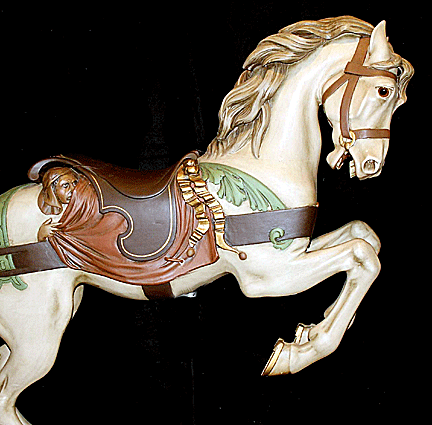 The
golden age of the American carousel lasted from the 1870s until the
Great Depression of the 1930's. With the decline of amusement parks and
the economy in general, the demand for new carousels dried up and
companies closed. Many carousels stood abandoned or were dismantled for
parts. The
golden age of the American carousel lasted from the 1870s until the
Great Depression of the 1930's. With the decline of amusement parks and
the economy in general, the demand for new carousels dried up and
companies closed. Many carousels stood abandoned or were dismantled for
parts.
As the mid-20th-Century dawned, the carousel couldn’t compete with wild
roller coasters and thrill rides and went from being an adult ride to a
children’s ride at the few remaining amusement parks. Cast aluminum and
later fiberglass replaced the beautifully carved animals.
During the 1970's, a renewed interest by collectors in carousels and
their animals once again brought the carousel into the limelight.
Respected as fine woodcarving and the ultimate decorator item, the value
of surviving animals went from a few hundred to several thousand dollars
in just 10 years. Antique dealers purchased and dismantled many
carousels for the profit that could be made, for no one really wanted to
purchase an entire carousel and more profit could be made selling one
piecemeal.
Carving
Styles
Carving the elaborate carousel animals was an art. Craftsmen carved
their horses in three basic styles: Coney Island, Country Fair, and
Philadelphia.
The Coney Island horses, built by carvers and companies such as Charles
Looff, M.C. Illions, Charles Carmel, and Stein & Goldstein, for the
Coney Island amusement Park, had animated poses, golden, waterfall
manes, elaborate buckles and rose bouquet carvings, and glass jewels.
These big, passionate animals had their ears pinned back, their nostrils
flaring, their eyes wide, and their tongues hanging out.
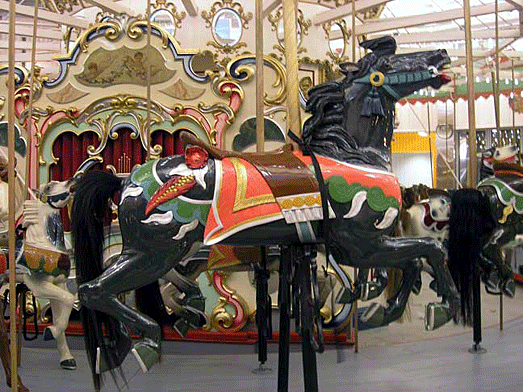
German immigrant, Charles Looff, arrived in Brooklyn in 1870, working as
a furniture maker by day and dance instructor by night. In 1876, he
built Coney Island's first carousel, working alone in his basement
carving each horse from leftover wood he'd brought home from the
factory. Looff moved his shop to Riverside, Rhode Island, in 1905.
Charles Carmel, a Russian immigrant employed by Looff, used the horses
ridden in Brooklyn's Prospect Park as models. Only once in 1911, did he
try to work for himself. He built the Carmel carousel, intended to
operate at Dreamland Park, which burned on opening day, taking the
entire park with it. Financially ruined, he continued carving horses for
others.
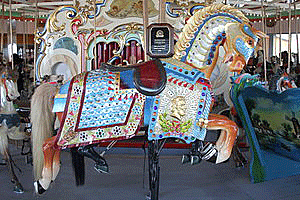 Of all horse carvers, Mike Illions is
king. Illions carved carousels and
circus wagons in England before emigrating to America in 1888. He worked
for Looff before opening his own business in 1909. He was one of the
only carvers to sign his king horses. Of all horse carvers, Mike Illions is
king. Illions carved carousels and
circus wagons in England before emigrating to America in 1888. He worked
for Looff before opening his own business in 1909. He was one of the
only carvers to sign his king horses.
Solomon Stein and Harry Goldstein emigrated from Russia to escape
anti-Semitism. Instead, they found jobs carving flowers on ladies' combs
in Brooklyn. By 1905, Stein and Goldstein began carving horses,
embellishing their animals with cabbage rose bouquets. Like Carmel,
their first S&G carousel, in Virginia Beach, burned to the ground. Left
with $20,000 in debt, they turned to operating carousels, rather than
carving them. Of the 17 they created, they owned eleven.
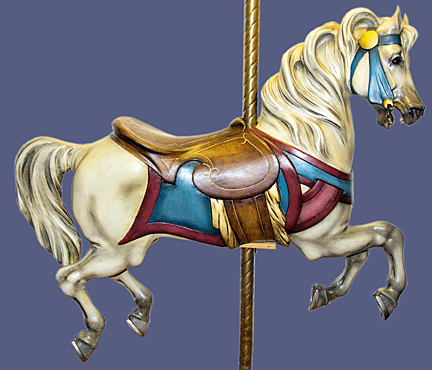 Carvers, such as Allan Herschell and C.W. Parker, produced Country Fair
style horses for rural fairs and traveling carnivals, making them simple
and durable. They carved the horse's ears flat against the horse's head
and their legs outstretched to keep them safe during transport. Carvers, such as Allan Herschell and C.W. Parker, produced Country Fair
style horses for rural fairs and traveling carnivals, making them simple
and durable. They carved the horse's ears flat against the horse's head
and their legs outstretched to keep them safe during transport.
It was said that an Allan Herschell steam-driven carousel "took a cowboy
to ride it." The Scotsman, struck by malaria in 1882 while visiting New
York City, envisioned his first Herschell Steam Riding Gallery while
bedridden with fever.
C.W. Parker, later known as Colonel Parker, Carnival King, started out
as a $32-a-week janitor at the Dickenson County Court House in Kansas.
Saving his money to buy a second-hand carousel, he created the Parker
Carnival Show. What his horses lacked in flamboyance, he made up for in
showmanship, forging his name on the shoes on his carousel horses.
To the west of Philadelphia lies jumping horse country, so it’s only
natural that Philadelphia style horses were large, realistic animals.
First created by Gustav Dentzel in the late 1800s, his son, William, and
family associate, Daniel Muller, continued with the style. Dentzel was
especially known for creating the sweet-faced mare, and Muller for
cavalry mounts representative of the Civil War and pre-World War I
periods.
Nicknamed "Hobby Horse Bill," Willliam Dentzel slept as a baby in a
soapbox cradle strapped to the horse which powered the carousel for
which his mother collected tickets. A good carver, Dentzel dedicated
himself to managing the family company after his father’s death in 1909.
Five generations later, the Dentzel Carousel Company still exists in
Port Townsend, Washington.
Perhaps it was Daniel Muller’s study of classical sculpture at the
Pennsylvania Academy of Fine Arts in Philadelphia, that caused him to
develop an interest in the U.S. Cavalry horses of the Civil War and
pre-World War I periods and later to make them his trademark.
Identifying Carousel Horses
Collectors identify carousel animals by the name of their main carver.
Many companies
began with one person. In many cases, however, these companies grew to
include many carvers, painters, and machinists. Horses and chariots
would be created by a staff of carvers with the master carvers doing the
heads and detail on the outside animals while the apprentice carvers
glued the wood, carved the legs and bodies and practiced their skills on
the simpler inside-row animals.
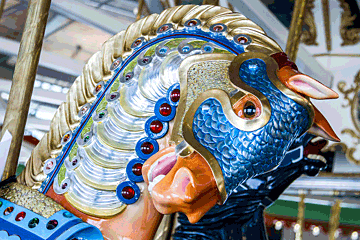 Unfortunately, many carousel lovers buy animals without really knowing
anything about them. The decorator market has spawned an entire carousel
animal carving industry in Indonesia and Thailand. Many carousel lovers
unwittingly buy these recently carved knock offs from antique shops and
auction houses with no provenance to speak of. Of course, those
interested in them for decorative purposes most likely don’t care that
they’re authentic. However, they usually pay too much for them, buying
them as antique carousel pieces rather than the new ones they really
are. Unfortunately, many carousel lovers buy animals without really knowing
anything about them. The decorator market has spawned an entire carousel
animal carving industry in Indonesia and Thailand. Many carousel lovers
unwittingly buy these recently carved knock offs from antique shops and
auction houses with no provenance to speak of. Of course, those
interested in them for decorative purposes most likely don’t care that
they’re authentic. However, they usually pay too much for them, buying
them as antique carousel pieces rather than the new ones they really
are.
Detecting these knock-offs is fairly easy. If it's intricately carved on
both sides, it's not American. That's because American craftsmen working
between 1870 and 1930, the heyday of the carousel in this country, spent
most of their time carving the outside of their animals because that's
the only part visible to people watching a spinning carousel.
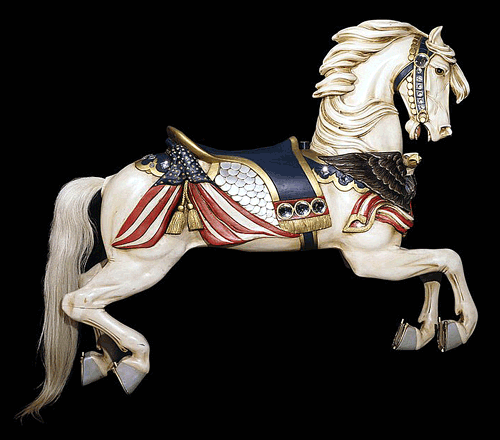 After a collector identifies a horse as American-made, three
characteristics determine its worth—who carved it, where it sat on the
carousel, and whether it has any extraordinary features. These items, as
well as the animal’s condition and its paint, determine its value.
Carousel lovers will pay as much as 10 times more for an outside horse
than an inside one from the same carousel. Details that give a
particular horse character, such as an especially vivid facial
expression, also increase its value. Prior to 1980, collectors could
purchase an original American carousel animal for less than $50, if not
for free. But not any longer. After a collector identifies a horse as American-made, three
characteristics determine its worth—who carved it, where it sat on the
carousel, and whether it has any extraordinary features. These items, as
well as the animal’s condition and its paint, determine its value.
Carousel lovers will pay as much as 10 times more for an outside horse
than an inside one from the same carousel. Details that give a
particular horse character, such as an especially vivid facial
expression, also increase its value. Prior to 1980, collectors could
purchase an original American carousel animal for less than $50, if not
for free. But not any longer.
Today, finding an authentic wooden carousel animal is like winning the
lottery. A horse costing $45 in 1970 could be worth $45,000 today.
Generally, American carousel horses sell for $1,500 to $160,000. Most
are in the $5,000 to $10,000 range.
The most expensive horse ever sold was an Illions for $125,000. The most
expensive animal was a Dentzel St. Bernard, which sold for $250,000.
Carousel carvers never intended their animals to last 100 years. That
they have survived at all is nothing short of a miracle.
<
Back to Antiques Archives
Next Article >
|
